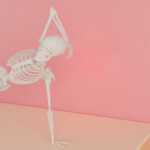Are you ready to delve into the enigmatic world of the human spine? Brace yourself, for we are about to embark on a journey that will unravel the mysteries of its intricate structure. In this article, we will explore the hidden complexities of the spine, shining a light on its remarkable architecture and the vital role it plays in our overall health and mobility. Get ready to marvel at the wonders of biomechanics, unravel the secrets of musculoskeletal disorders, and gain insights into surgical interventions that revolve around this marvel of nature. So, grab a seat and prepare to have your mind blown as we navigate the captivating terrain of the spine’s remarkable structure.

Intricate Structure of the Spine
The spine, also known as the vertebral column, is a fascinating and complex structure that plays a crucial role in supporting our bodies and facilitating movement. Made up of 33 individual bones called vertebrae, the spine serves as the central axis of the musculoskeletal system, connecting various parts of our body and allowing us to sit, stand, walk, twist, and bend.
The spinal column is divided into five regions: the cervical, thoracic, lumbar, sacral, and coccygeal regions. Each region is comprised of a specific number of vertebrae, all serving their unique purposes in maintaining our overall health and mobility.
Intricate and delicate, the spine possesses two sections of naturally fused vertebrae at the bottom called the sacrum and the coccyx. These fused vertebrae lend stability to the spine and provide a foundation for the structures above them.
At the core of the vertebral column lies the spinal cord, housed within the cervical spine. The spinal cord serves as the main channel through which the brain communicates with the rest of the body, sending and receiving vital signals that control our movements and bodily functions.
The vertebrae themselves are fascinating ring-shaped bones that form the protective barrier around the spinal cord. They not only safeguard the delicate nerves but also provide support to our bodies, maintaining our posture and allowing us to move freely.
Each individual vertebra is composed of three main parts: the body, the arch, and the processes. The body acts as the weight-bearing part and is crucial for the overall strength and stability of the spine. The arch protects the spinal cord by creating a bony canal, while the processes serve as attachment points for muscles and ligaments, providing further support and flexibility.
To understand the spine’s functionality, it’s important to grasp its ability to twist, bend, and sway with the trunk. This flexibility allows us to perform a variety of movements, from simple everyday tasks to more complex activities. However, it also makes the spine vulnerable to injuries.
Back injuries, spinal cord conditions, and other problems can damage the spine and cause debilitating back pain. Hence, it is essential to take proper precautions and seek medical attention when necessary to preserve the spine’s intricate structure and ensure its optimal functioning.
In our everyday lives, we often overlook the significance of the ligaments, which provide crucial support to the vertebral column. These strong, fibrous bands hold the vertebrae together, allowing stability and preventing excessive movement that could lead to injury.
To fully comprehend the intricate structure of the spine, we must appreciate its immense contribution to our overall well-being. It connects various parts of our body, supports our head, neck, and body, and protects the spinal cord, the delicate pathway between our brain and the rest of our body.
In conclusion, the spine’s structure is a marvel of nature, allowing us to move and navigate the world around us. Understanding the intricacies of the spine not only empowers us to take better care of our bodies but also fosters an appreciation for this remarkable component of human anatomy. As we delve deeper into the magnificent design of the spine, we unveil its ability to maintain our health, stability, and mobility. So, let’s embark on this exploration of the remarkable structure that is the spine!
Here’s an example of an active internal link with the anchor “Spine Trivia Questions” and URL “../spine-trivia-questions”:
“Are you ready to test your knowledge about the fascinating world of spines? Look no further! We have compiled a set of intriguing spine trivia questions that will challenge even the most knowledgeable spine enthusiasts. From the anatomy of the vertebrae to spine disorders and treatments, these questions cover a wide range of topics. Click here to dive into the world of spine trivia questions and see how well you know your vertebral column: Spine Trivia Questions. Get ready to become a spine trivia master!”
Remember to format this in Hugo syntax for your website.

FAQ
Question 1
What is the spinal column composed of?
Answer 1
The spinal column is composed of 33 individual bones called vertebrae, which provide support for the body and protect the nerves.
Question 2
How many sections are there in the spinal column?
Answer 2
The spinal column has five sections: cervical, thoracic, lumbar, sacral, and coccygeal. These sections provide flexibility and stability to the spine.
Question 3
What are the functions of the cervical spine?
Answer 3
The cervical spine consists of seven stacked vertebrae and houses the spinal cord. It supports the head, neck, and body, allowing for movements such as twisting, bending, and swaying of the trunk.
Question 4
What are the important parts of the spine’s ability to function properly?
Answer 4
The coccyx and sacrum, which are two sections of naturally fused vertebrae at the bottom of the spine, are important parts of the spine’s ability to function properly.
Question 5
How does the spine connect different parts of the musculoskeletal system?
Answer 5
The spine serves as a connection between different parts of the musculoskeletal system, enabling activities such as sitting, standing, walking, twisting, and bending. The ligaments also provide support for the vertebral column.
- Jerry McSorley’s Post-Divorce Life: New Beginnings - July 16, 2025
- The Rise and Fall of the New Haven Nighthawks: A Minor League Hockey Legacy - July 16, 2025
- Unlock Jerry McSorley’s Career Highlights: Eye Tax Inc.’s Solar Success - July 16, 2025
















